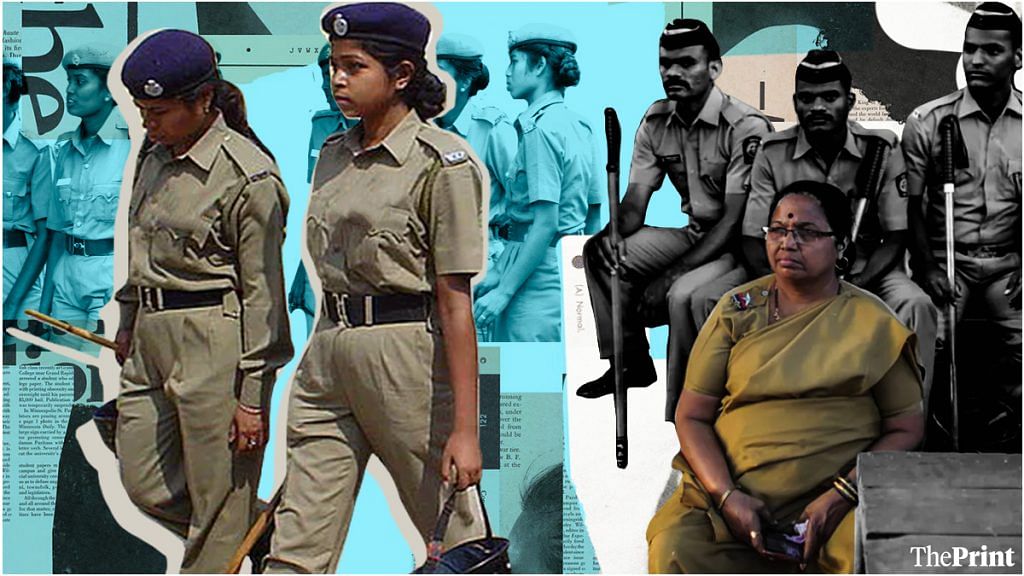The limelight comes easily on women in police whenever they perform well. However, the fandom built around women in uniform, online and offline, conceals more than it reveals.
While women’s share in the coveted Indian Police Service (IPS) in recent years has remained stagnant, the Bureau of Police Research & Development (BPRD) data shows that this number is only 12 per cent for the overall police force. The slowly rising share of women in police leadership roles, however, has not translated into a discussion on the nature of women’s professional engagement within the police force. Do women constables own up the same powers and responsibilities as their male colleagues do?
The standing divide
The jurisdiction of a police station is divided between ‘beats’, and beat constables are appointed for investigation of crimes in an assigned area, enquiry into complaints, attending to law-and-order situations, community policing and serving as an interface for police-public relations. These are essential ‘executive’ duties and the core aspect of policing.
Women constables at police stations are usually allocated desk duties or general duties. In my 10 years of service, I did not meet a single woman head constable in charge of a police beat. It is interesting to note that the impetus for the induction of women in the police force came from the fact that they could counsel, touch, arrest, and pursue other women in course of their engagement with the public. It is no surprise then those women constables have remained relegated to organisational fringes, often seen in nominal rather than substantive roles. There is a need to re-work the participation of women in police beyond just ‘pink squads’ and ‘anti-Romeo squads’.
Women donning a crisp uniform may not translate to equitable and just treatment at work or home. The gendered division of labour in the private sphere, where women primarily serve as the caregiver, also mediates their participation in the public sphere. The woman constable still has to perform the ‘duties’ assigned to her ‘gender role’ at home that hinder her from doing ‘gender neutral’ duties at work.
Also read: Indian law needs to account for women, make finance inclusive
A lopsided work-life balance
Without the necessary support structures at home and work, the physical uniqueness of child-bearing and breastfeeding means that the progress a woman constable makes in her personal life puts her behind in her professional life. They may then prefer specific types of duties, which may ease the lopsided division of work at home. Lived experiences of women constables and how they perceive their work cannot be easily bracketed by simplistic explanations. The incongruity between the professional role of women constables and the perceived gender attributes plays out in complex ways.
However, the evidence in favour of women as a visible, robust, and integral part of the civil police force is incontrovertible. It is time to infuse freshness. As the Superintendent of Aurangabad (Rural), I was pleasantly surprised to see 37 women constables respond to our call to work as “beat in-charge or beat amaldars” when I expected only a handful.
The distribution of executive duties equally between men and women in the constabulary instantly enhanced the productivity of the police workforce and bolstered the public trust that eased the police-public interface. It was a learning experience to witness men and women constables exchange notes on their professional problems with me as well as each other. It was heartening to hear a male constable trying to put things in perspective when a newly appointed woman incharge expressed her doubt about assisting the inquest panchnama of a male body found in her beat. As their Superintendent, I could not be happier.
Also read: Job insecurity will increase if Indian firms don’t tackle rising employee dissatisfaction
Way ahead
It is time to infuse a fresh sense of purpose towards creating a conducive and substantive work environment for the women’s constabulary. Such a system with integral and active participants could ease several operational challenges for the police as an organisation and provide a significant boost to its productivity. The operational advantages make for a convincing case for the police leadership at regional scales to consider. The task of implementation was made easier in the case of women ‘beat amaldars’ of Aurangabad due to the support and conviction of the regional leadership.
This is a key organisational overhaul that the police force in India needs to provide better policing services to its people. Issues pertaining to housing, toilets, childcare rooms, long travels, and even longer hours of physical hardship are quite palpable when one ventures into the field. Despite these, men and women in police have served society in the face of myriad challenges. It is high time to include women constables in active public engagement and investigations of all cases and core executive duties in their beats as a norm.
It may be said that without critically re-imagining and re-inscribing the familial gender roles, any intervention to foster women’s substantive participation in the public sphere may be ‘impractical’. However, concern for the ‘practicality’ of issues has surprisingly solved very few problems. Setting up ideals and untiring pursuit of them has proven to be a path that, though slower, is worth taking up. At home as at work.
Mokshada Patil is an IPS officer. Views are personal.
(Edited by Humra Laeeq)
